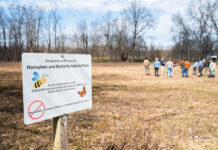Now is a time of year many cow-calf operators enjoy because the season’s calf crop has been sold, all the hay has been made, most of the equipment is put away and there is a little extra money in the bank.
It should also be a time to reflect on management practices to identify changes that could be made to increase production and reduce costs in the future.
Change. Change is something many producers do not like to think about, let alone do. Monumental changes do not have to be made to make a significant difference in net earnings.
For example, evaluating each paddock’s production for the past grazing season and where to feed forage the remainder of the year would be good places to start. If some paddocks did not produce the amount of forage you expected, was it a nutrient deficiency or a mistake in management such as overgrazing? Take a soil test.
Paddock maintenance. If it was nutrients, maybe you should consider feeding hay in those areas to add manure and organic material to build soil tilth for the years ahead. If it was overgrazing, monitoring more closely the amount of time livestock are on a paddock next year. That may be all that is necessary.
Leaving enough residual cover and supplying adequate rest between grazing will improve grass growth. Growing more grass per acre allows more carrying capacity and provides opportunity for increased earnings.
Separating the herd. Another inexpensive change may be to separate all cows by Body Condition Scores (BCS). This means looking at your cows and rating them on a numerical scale of 1 to 9, one being emaciated with little muscle, nine being excessively fat.
Sorting cows and supplying the appropriate quality feed to meet their needs is very cost effective. It is a way to bring thin cows up in body condition while fat cows can be fed so they merely maintain there current condition.
Proper body condition. There is no better time to get the thin cows in proper body condition for spring calving than now because net energy for maintenance is at the lowest point of the production cycle immediately after weaning.
Body Condition Scores description charts with pictures may be obtained through many local Extension offices or found online at http://ohioline.osu.edu/l292/index.html.
Good grazing management can decrease out-of-pocket expenses for supplemental feed. Fewer problems occur at calving and rebreeding is more successful when cows are in proper body condition.
Overlooked expenses. With today’s market prices each heat cycle a cow does not rebreed, after the bull is turned in, costs you the producer about $75.00. This expense is often overlooked by managers because they do not have to physically pay a bill, but the income is lost.
Do you have any stockpiled grass to feed? Most of the time the quality of stockpiled grass is as good as, or many times better than, most first cutting hay that was made during the summer. This would be a good place to allow thin cows to graze and monitor their BCS scores.
Feeding lower quality hay along with stockpiled grass might be a good fit for the fat cows. This way you can utilize some of the stored forages that do not have as much nutritional value, you do not have to buy expensive supplements to meet dietary needs and you can save your best quality hay to feed at or near calving time when nutritional requirements become greater.
Comfort zone. Well-nourished, stress-free cows are the basis of a sustainable beef cattle operation. Animals that are healthy perform better, are easier to manage and they handle adverse weather conditions of winter more easily.
The comfort zone of beef cattle is 30-75
Get 4 Weeks of Farm and Dairy Home Delivered











